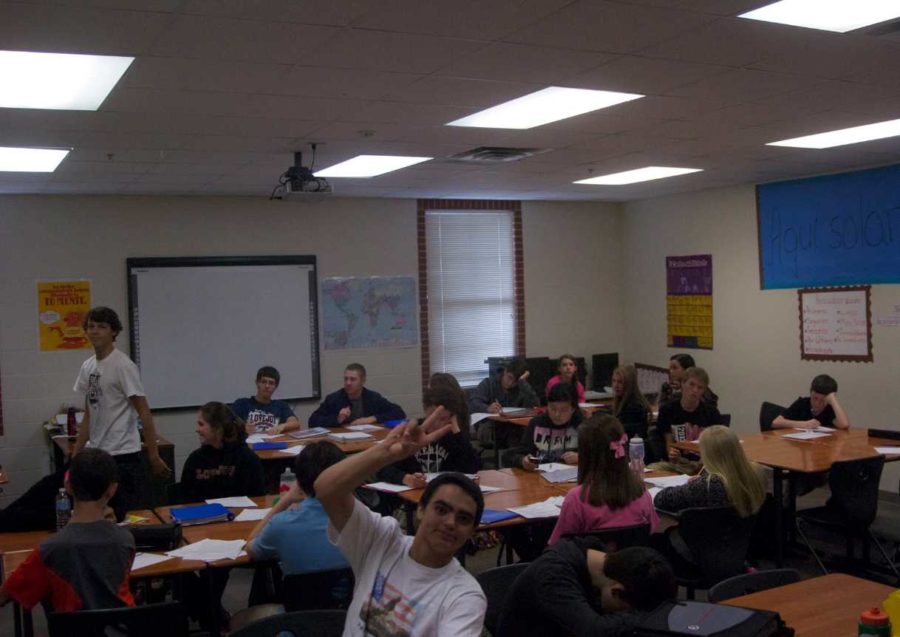Spanish classes combined
The spanish four and five classes have been combined, and are now the same period with the same teacher.
November 14, 2013
For many high school students, college level foreign language classes are not the easiest in the best of circumstances. But for Mallín Hernandez and her sixth period class, it is even more difficult. Because of the low number of students taking AP Spanish 4 and AP Spanish 5 literature, both courses are mixed together in one classroom.
“It was either that or not have it, so they decided to put it in one period, just because of numbers,” Hernandez said. “It’s only 12 students between AP Spanish 4 and AP Spanish 5 literature. They are two completely different curriculums, two completely different classes. It’s very challenging, because in a 45 minute period, it’s my goal to give each class a 45 minute period.”
In some ways, putting the small classes together can be helpful. While AP Spanish 5 often gets a review of older material, AP Spanish 4 can get a taste of the Spanish literature. But Hernandez has to set time aside for both classes and teach separately because they are so different.
“The challenge is that my Spanish 4 AP class is a hard class, it’s hard context, they tend to get distracted because the material is difficult,” Hernandez said. “My Spanish 5 lit kids are super into the class, into the language, into the culture. They want to learn it, they want to read it, they’re very into it, they’re very serious about it. And my Spanish 4 class is not so much like that, so it’s a contrast. That’s one of the challenges, to find the right balance between that.”
Hernandez generally spends more time working with AP Spanish 4 while the more independent AP Spanish 5 literature students complete their reading assignments.
“Sometimes she’ll be on one side of the room, and we’re doing our own thing,” sophomore Audrey Morris, AP Spanish 5 student said. “Sometimes I don’t like it because we get more stuff to do and it’s two AP classes, so it drives the teacher crazy. There’s only a few of us in Spanish 5, and a few more in Spanish 4. But it gets kind of crazy sometimes.”
To make up for lost time, Hernandez and the Spanish 5 students will occasionally have a “zero hour” where they come in before class in the morning to work. But Hernandez has high expectations for all of her students.
“It’s a challenge with the classroom management,” Hernandez said. “I have my goals very clear: this is what you’re going to do, this is what I expect, I have two periods in here. These are two college-level classes, they’re AP, so I expect college-level behavior from them. So if I say, this is what we’re doing, these are the instructions, and I expect it to be done tomorrow at this time, then I expect it to be done tomorrow at this time. When it doesn’t happen, then they’re responsible for that. So that’s the way I’ve been able to manage them.”
The mix of students can make learning complicated, even with extra measures taken to help both groups.
“Honestly, I think it’s not the best situation, because the teacher has to give attention to both classes, and it’s difficult for each class to get the amount of attention it needs,” AP Spanish 4 student Colin Cross said. “But Mrs. Hernandez is doing her best.”
While there’s no perfect system, Hernandez is flexible and changes according to the needs of the students.
“I’ve never had two classes together like that, it’s been a challenge for me, but it’s doable I think,” Hernandez said. “We’ll see how it works with the AP tests at the end, see if it works. Two college levels are two college levels, and it’s the same amount of work, and it’s a lot of work. And even if they weren’t together, a lot of it depends on how their work ethic. A lot of it depends on how much time and effort they put into it, how much interest they have, so having it together is an added challenge in itself. Separate or together, a lot of it depends on interest or effort.”




